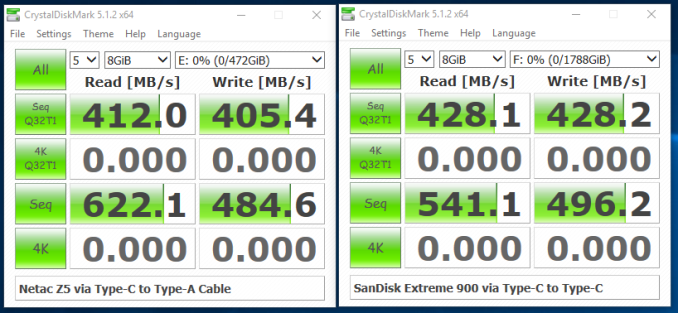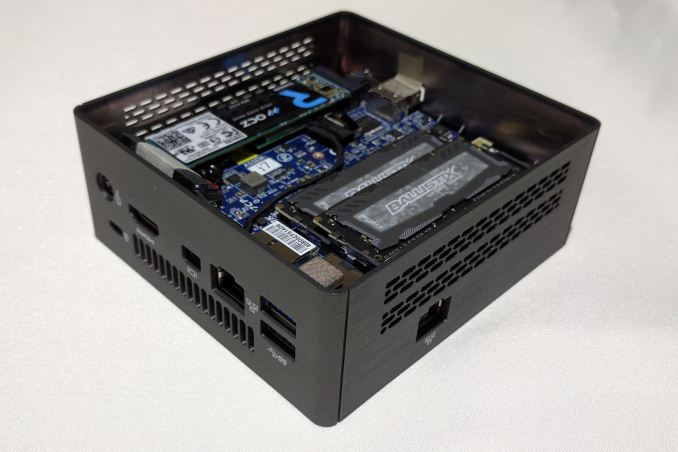GIGABYTE GB-BSi7HAL-6500 Dual LAN Skylake BRIX Review
by Ganesh T S on September 21, 2016 8:00 AM ESTMiscellaneous Aspects and Concluding Remarks
The dual Gigabit LAN feature of the GB-BSi7HAL-6500 is unique. We have already discussed the networking appliance use-case for the PC. Other aspects that differentiate various Skylake-U UCFF PCs include the PCIe peripherals and the OPI configuration. On the former front, GIGABYTE has chosen to connect a ASMedia ASM1142 bridge chip to the PCH via a PCIe 3.0 x2 link. The other side of the bridge chip is configured to provide one Type-A and one Type-C USB 3.1 Gen 2 port in the front panel. The ASM1142 chip also has a x1 uplink configuration that could limit the simultaneous bandwidth availability. Fortunately, the ASM1142 in the GB-BSi7HAL-6500 is configured to provide maximum possible performance. To evaluate this, we connected the Netac Z5 and the SanDisk Extreme 900 to the system at the same time. In the first pass, we ran the sequential read and writes (queue depth of 1) one after the other. In the second pass, we triggered the QD32 sequential tests on both units at the same time.
It appears that the bridge chip is able to support around 800 MBps of traffic. We will check out the effects of a PCIe x1 uplink to the Skylake-U PCH for the same bridge chip in one of the upcoming reviews.
In terms of scope for improvement, the BIOS could definitely do with some more options such as the ability to operate the USB 3.0 ports in USB 2.0 mode and some control over the DRAM timing parameters for power users. Instead of a power brick adapter, GIGABYTE could opt for the more compact wall wart (such as the one bundled with the Intel NUC6i5SYK). An extra USB 3.0 port adjoining the second LAN port on the side could turn out to be useful under certain usage scenarios. On the platform side, we find it hard to see a situation where the ASMedia USB 3.1 Gen 2 controller is a better option compared to the Intel Alpine Ridge controller. The GB-BSi7HT-6500 sells for $485 and comes with a Thunderbolt 3 / USB 3.1 Gen 2 Type-C port, a SDXC slot and HDMI 2.0. For more than $100 extra, the GB-BSi7HAL-6500 provides one additional USB 3.1 Gen 2 Type-A port and an extra RJ-45 port, but loses Thunderbolt 3 and the SDXC slot. Given the versatility of Thunderbolt 3, a GB-BSi7HTL-6500 at $500 would have been perfect.
Coming to the business end of the review, we can discuss two different angles - GIGABYTE's Skylake BRIX lineup in general and the GB-BSi7HAL-6500 in particular. On the former front, it can be safely said that GIGABYTE has analyzed the target market for UCFF PCs extensively. They have managed to create a single platform that only needs slight tweaks in order to cater to specific market segments. The wide variety of offerings range from Thunderbolt-capable UCFF PCs to units focused on industrial applications and targeting specific embedded market segments such as networking appliances. GIGABYTE's comprehensive Skylake BRIX offerings include more than 20 different SKUs that can cater to every market need and budget. All other vendors have restricted themselves to two or three SKUs for their Skylake-U products, differentiated only by the processor.
The GB-BSi7HAL-6500 is currently priced at $591 on Amazon. From the viewpoint of x86 networking appliances with comparable horsepower, the pricing seems par for the course. However, in terms of being a generic PC, it is difficult to recommend it against something like the Skull Canyon NUC (NUC6i7KYK) which costs less than $30 more, but handily scores better in the benchmarks while also being quite extensible (thanks to Thunderbolt 3 and the number of docks that are coming into the market). That said, the NUC6i7KYK, based on a 47W Skylake-H CPU, is not as compact or as power-efficient as the GB-BSi7HAL-6500.
All said, the GIGABYTE GB-BSi7HAL-6500 is a compact, yet powerful networking appliance platform. Thanks to its configuration and feature set, it also emerges as the best performer amongst all the Skylake-U platforms that we have evaluated so far.












25 Comments
View All Comments
cknobman - Wednesday, September 21, 2016 - link
The price on these platforms is downright ridiculous.I know small has its price but at this point it just seems like Intel is profiteering.
powerarmour - Wednesday, September 21, 2016 - link
That price is an utter joke.ddriver - Wednesday, September 21, 2016 - link
More like mockery.nagi603 - Thursday, September 22, 2016 - link
Yeah, for the same price, (well, actually quite less, but with "only" 16GB ram and a 256GB SSD) I put together a mini-ITX box with a proper desktop-class i7.... And thanks to the bigger size, it is quite silent.JoeyJoJo123 - Wednesday, September 21, 2016 - link
You know, I actually got rather excited when I saw it'd be a dual LAN mini PC on Skylake, as this would work out very well for a pfSense router-box.>$591.
>$1030 as configured.
No thanks... Might be better to stick with one of those cheap chinese dual lan mini-PCs instead...
barleyguy - Thursday, September 22, 2016 - link
The Zotac ZBox EN760 has GTX 960 graphics as well as the dual lan ports, and could easily be configured comparably to this. That probably falls in your "cheap Chinese mini PCs" category, though I think Zotac is Tawainese.It's possibly on a lower quality tier than the Intel NUC or Gigabyte Brix. That said, I have the older version of it (EN860) and it works great as an HTPC box.
I have actually considered the Intel NUC for use with Thunderbolt pro audio. If you're pairing it up with thousands of dollars of studio gear the price seems less egregious. But if the Thunderbolt port is going to go unused, there's really no reason to choose that direction.
JoeyJoJo123 - Thursday, September 22, 2016 - link
The discrete graphics adds additional heat and cost that isn't useful for a pfSense box. It essentially acts as a server/router, using one LAN port as a WAN directly from a modem, then routes packets out accordingly from the other LAN port(s).Many Chinese fanless versions exist, but they use anemic celerons and atom CPUs. When you start using many extra features of pfSense, like squid (as a webproxy) the router's maximum throughput drops. Now this isn't an issue unless you have some kind of insane symmetrical 1gpbs up/down connection, where processor would fail to saturate the entire pipe.
I'd prefer to not have to worry, so I'd be all in for a fanless Mini-STX case and socketing in my own 6300T or something, but there are no fanless Mini-STX cases, and no Mini-STX motherboards with dual LAN. There are fanless thin Mini-ITX cases from Akasa, but I wasn't able to source a cheapish i3 + thin Mini-ITX mobo with dual LAN.
fanofanand - Wednesday, September 21, 2016 - link
$1030 using an iGPU. Pass.fanofanand - Wednesday, September 21, 2016 - link
Had to post a second comment, comparing this to the Skull Canyon, which has a better GPU/CPU, better wi-fi, and a better SSD really hurts the Brix. $3 less for nearly every component being better except 16 GB of RAM vs 32 GB. What use case does this box have where 32 GB of RAM becomes a factor? Are people running dozens of VMs off a box like this? I don't know about profiteering, but I don't see them selling many of these.kmmatney - Wednesday, September 21, 2016 - link
I can't see running too many VMs. The i7-6500U performs worse than an i3-6100 (uses a lot less power, but still...). I know going into these reviews that the prices will shock me, yet I'm still shocked when I see them.